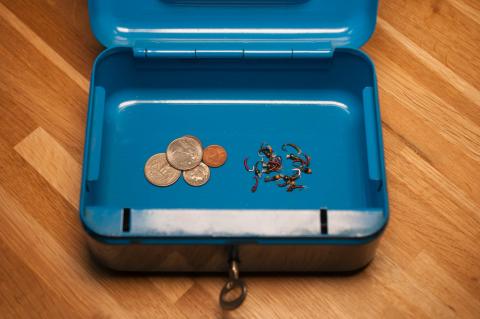Recent comments
I have my first batch of chickens that I am rasing for meat and would like to use the feathers for fly fishing. My only problem is that I have a variety of chickens and dont know what kind they are. Would this be a problem for selling the feathers?
- Log in to post comments
What powerful information. Being a first timer fly fishing, your reading has given me the confidence and the excitement I've been looking for. So rich with information on how to and what not to do is amazing. I have never been so involved in fishing before in my life. I've read books, went online, and u tube and gained a lot of information that has kept me up into the wee hours of the morning just setting up my gear. :)
- Log in to post comments
I have spent on Danish coast approx. 80 days so far so I am not so experienced as Martin or as other danish guys.
I have tested a lot of tackles there and I prefer shooting heads or special lines similar to shooting heads too. So my first choice is Rio Outbound in floating or hover version.
I have fished with 5wt, 6wt, 7wt and 8wt rods there and in my opinion fast 6wt rod is all rounder. 8wt rod is too heavy for me. If the wind is too strong I change the place.
- Log in to post comments
Alexander,
I have actually written a whole article on the subject of selecting gear for sea trout fishing on the coast - sparked by your post here! It will be online soon.
Regarding lines, I use shooting heads almost exclusively. They will help you cast with less effort, and can also be constructed to fight the wind.
See more here:
http://globalflyfisher.com/fishbetter/shootingheads/
and here
http://globalflyfisher.com/keywords/?keyword=shooting_heads
Martin
- Log in to post comments
Thank you Martin for an answer!
To the habitants of the Kaliningrad area God was not gracious as to the habitants of island Fyn, at western, north-western, north, north - easterly winds by force more than 5 meters in a second the hidden nowhere, as we did it on Fyn, moving on other side of island.
Here on this account I thought that for a fight against wind more powerful class is needed. But as practice showed with force wind even less than a 5 m, but meeting directions of fly fishing simply not possible. Here for us spinning rules.
But experiments I it will continue. Can you recommend fly lines?
With kind regards
Alexander
- Log in to post comments
Dear anonymous,
Click on the image to get a larger and better version, where the details are more visible. We have heard your comment before, and while I certainly respect the view I don't think the problem is that severe, and I honestly don't think that uniform, colored backgrounds are good for anything else than analytical images, documenting flies.
I have changed the backgrounds on the latest tying series (this one was shot in 2009), but don't expect us to turn to absolutely uniform backgrounds anythime soon. These flies are usually tied at a tying desk, and shot over the shoulder of the tyer, and although we will make the table and background tidier, it will probably never be 100% uniform.
Martin
- Log in to post comments
It would be nicer to follow if some sort of light background was behind the fly tying rather than a clutter of gear, find it difficult to follow, sorrry.
- Log in to post comments
Alexander,
Your English is certainly better than my Polish! No need to apologize.
Regarding gear for fishing the Danish coast, I can only recommend you to go light. I myself and the guys that I fish with use much lighter gear than you, and my personal favorite rod for the coast is a 9 foot 5 or 6 weight rod equipped with a neutral, very slow sinking shooting head. I personally use a 9-12 foot monofilament leader and a 0.23mm tippet, but I know others who use polyleaders.
Some people prefer WF lines, but I find shooting heads more efficient when you need to cast all day. I do use WF lines when night fishing and sometimes when fishing under really calm conditions.
I also meet people who prefer heavier rods, but it's actually quite rare to meet anything heavier than a 7 weight, although some might go as heavy as 8 or 9 weights, but I personally find that way too much work when the assignment is to cast and cast as it is in Danish coastal fishing.
You can argue that the heavy rods cast better in hard winds, but I personally fish places where the wind helps me rather than places where I have to cast against the wind.
If you want to fish large flies in onshore winds as it's favored by many (mostly foreign) anglers, you will need heavy gear. But this type of fishing is hard work anyway, fighting waves, wind and weed in the water.
Hope this helps and answers your questions.
Martin
- Log in to post comments
Anonymized commenter,
I have had several types of Dacron backing, and most the stuff you can boy nowadays is too thin and soft to work. I do have an old coil of thicker and stiffer backing around that I can cut from when I need it.
I'm sure braided mono will work just as fine. It's the hollow braid that's the key, and yes it is exactly the "Chinese fingercuff" phenomenon that does it. The harder you pull, the more it tightens.
Martin
- Log in to post comments
Darren, i just received some of the new Mustad L87(formerly ther 3665A) I held a Size 2 up against my old 3665A #2 and the new ones are about an 1/8th of an inch longer that the old ones for a size #2. They are also finished much nicer that the old ones. They claim to be 3XH/7XL and I am sure they are exactly that. I thought you might want to update your page.
Cheers, Joel
P.S.
I, for one, will be using the new ones as soon as my old ones run out, maybe even before!!!
- Log in to post comments
Have you actually had success with braided Dacron? (Every other reference I've found calls for braided monofilament.) I'd love for Dacron to work since I already have it around.
Using 30 lb. test braided Dacron, I formed a nice, textbook-looking loop. Unfortunately, even a needle will not thread up in there very far, much less a length of fly line.
Is the "Chinese fingercuff" gripping action supposed to come into play here, or is that a mono-only phenomenon?
- Log in to post comments
This pattern is Great! I tied up a few and took them out tonight on the incoming tide and caught several nice Coho Salmon on Puget Sound.
I used Angel Hair as listed in the original recipe, I just cut it to fit the dubbing loop.
I have a pattern I use for Chum salmon in the fall, only I find the addition of the tail gives it a more fishy look in the water.
Thank you ! I will be twisting up some more of these to have in my box can't wait to try them in the local rivers for sculpin eating trout.
- Log in to post comments
Guys, GFF vsitors.
I really appreciate these couple of comments! We have many years ago pledged that GFF will stay non-commercial, and intend to stick to that. We have had some detours with banner ads and Google ads, but the work involved is way more than the payment rewards, and it's become a principle that we don't want to involve money in the form of sponsors or ads.
But a voluntary donation from the visitors sounds like a viable way of recouping a bit of the expenses involved. I will not bore you with amounts, but just say that running a site with 5-6000 visitors on a good day an a hundred gigabytes of traffic a month isn't cheap. I certainly don't want to try to calculate what GFF has cost us over the years, but just cherish the fond menories of all the good that this site has brought us.
I will seriously consider adding a Donate button! I have a PayPal account that supports this kind of thing, and it seems an easy task tos et up.
Thanks again!
Martin
- Log in to post comments
I think it is a pretty good idea to offer a Donate button to show our appreciation by donating money to help running the site of Globalflyfisher. I buy a lot of flyfishing magazines to keep up with all the news and products and that is a lot of money each month. But the most interesting I find on this site, so why not give a donation to keep up the good work, And it is a lot of work that people don't know about. I hope that all the readers will think about it , so we can enjoy this site for many years to come. Maybe a little advertising can help also !
Keep up the good work,
Tom Biesot.
- Log in to post comments
Thank you Martin.
For the one you gave me last Flyfair!
I keep it in my special display cabin.
I am tying a few of them today for my next Norway trip.
Late summer in Norway last year they caught a lot of Grayling for me
greetz Ted
- Log in to post comments
Very clever and very funny. Thank you for the laughter.
- Log in to post comments
[b:bbe0df9526]Here is a short article on the Coq-au-vin and its variations.
http://donaldnicolson.webplus.net/page445.html[/b:bbe0df9526]
- Log in to post comments
Here's a tip. Take a rubber band and put it onto your rod tight enough to hold onto the grip. Then when you take your rod apart, slip the end of your leader under the rubber band so that you can find it easily next time.
- Log in to post comments
If you watch any or all of the 7 available videos in this set and do not immediately book a trip to NZ you are not a fly fisher.
- Log in to post comments
Daniel,
The material is actually STF fibers (Synthetic Translucent Fiber) and not Angel Hair as I had first written. Ken Bonde tells me that SLF will also cut it, and Angel Hair might also. But Ken's own flies are made from STF
Sorry about the confusion!
Martin
- Log in to post comments
Is this really angle hair did he twist in the loop for the head?
- Log in to post comments
Eric,
The podcasts were fun to do, but also a lot of work. I have had several people approach me lately asking about them, and I might consider doing something again.
I don't go fishing as often as I used to due to health problems, and I'm not as energetic as I used to be for the same reasons, but I will seriously consider starting something up again.
I just need to find a form and a frequence that doesn't require as much work from me as the old ones did.
So don't give up hope completely!
Martin
- Log in to post comments

